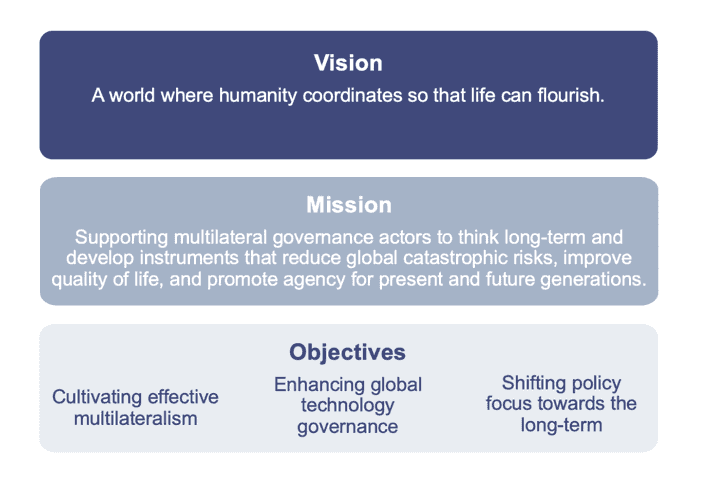Executive Summary
Until the end of 2025, SI will focus on improving the multilateral system’s capacity for the governance of rapid technological change, with a specific focus on AI. We see our strategic context as follows:
- The world is likely moving from a unipolar to a bipolar or multipolar order. Multilateral governance processes are contested via north-south tensions, tensions between the US and China are increasing, and private companies are increasingly providing global public goods.
- AI progress is inducing new policy challenges and exacerbating existing ones. Heightened public awareness of AI will amplify political discourse and increase the number of national, regional, multilateral, and private-sector AI governance processes being pursued, making multilateral policy coherence increasingly crucial.
- SI is a promising young organization facing a stress test. It has built expertise, credibility, infrastructure and networks to substantially contribute to multilateral frontier tech governance. Many funders have announced reductions in their giving due to economic uncertainty, while AI governance is gaining popularity amongst philanthropists.
Given this context, our priorities and goals are to:
-
Boost the multilateral system’s ability to prioritize, discuss and deploy solutions to reduce risks and maximize benefits from transformative technological advances;
- 1.1. Increase national demand for measured international action.
- 1.2. Support tech governance processes in leading international organizations.
- 1.3. Foster exchange and action within the multilateral tech governance system.
-
Advise national and non-governmental actors working on tech governance questions to act and communicate in ways that increase the likelihood of multilateral progress; and
- 2.1. Enhance civil society engagement in multilateral processes.
- 2.2. Contribute to the development of effective multi-stakeholder bodies.
- 2.3. Boost national awareness of multilateral affairs for international coherence.
-
Boost SI’s sustainability and operations.
- 3.1. Raise between 2.6MM-5.2MM CHF from a diverse set of funders.
- 3.2. Strengthen and grow the SI workforce to ~10 full-time employees.
- 3.3. Enhance SI’s operations, governance, and knowledge management.
Through these activities, we hope to contribute to building governance systems that are fit for the 21st century.
Introduction
The SI Strategy Implementation Plan is established every 2 to 3 years to implement the SI Strategy and the objectives outlined therein. It empowers SI to plan and take more focused actions in response to the broader global context and anticipated developments during those specific time frames.
The Priorities, Goals and Projects outlined in the Strategy Implementation Plan are reviewed regularly throughout its time frame to guide resource allocation and take into account any contextual changes. Progress is tracked and measured through the SI Monitoring, Evaluation and Learning plan.
Terminology
- Implementation plan: Our 2 to 3-year action roadmap.
- Short-term strategic context: Current trends in issues and governance shaping our priorities in the next 2-3 years.
- Priorities: Key focus areas for upcoming years.
- Goals: Desired outcomes within each priority.
- Projects: Time-bound sets of deliverables (outputs) that aim to achieve goals; can span multiple priorities.
- Finances: Budget (lower and upper bound expenses to deliver the plan)
- Monitoring, evaluation and learning plan: Our process to monitor, assess, and adapt.
Overview of SI’s full planning structure


Timeframe
June 2023 to the end of 2025.
Short-term strategic context
To define our priorities, we analyze the current short-term strategic context to identify key developments that shape SI and its environment. These developments occur on a short timescale, from the last ~3 years to the next ~5 years. Key implications for SI are in italics.
| Global governance context | |
| 1. The world is likely moving from a unipolar to a bipolar or multipolar order. |
|
| 2. Multilateral governance processes are contested via north-south tensions. |
|
| 3. Tensions between the US and China are increasing. |
|
| Technological change and governance context | |
| 4. AI progress is exacerbating existing challenges and inducing new ones. |
|
| 5. Heightened public awareness will amplify political discourse. |
|
| 6. The number of private, national, regional and multilateral AI governance processes are increasing. |
|
| 7. Multilateral policy coherence is increasingly crucial to achieve. |
|
| SI’s organizational context | |
| 8. SI has built credibility and networks to substantially contribute to multilateral frontier tech governance. |
|
| 9. Funders are reducing their giving due to economic uncertainty, while AI governance is gaining popularity amongst philanthropists. |
|
| 10. The SI team is young, still forming its expertise and building its infrastructure. |
|
Priorities & goals for 2023-2025
Based on the strategic context outlined above, we establish SI’s three-year priorities and set specific goals for each.
Priority 1: Advance multilateral technology governance
Short description: boost the multilateral system’s ability to prioritize, discuss and deploy solutions to reduce risks and maximize benefits from transformative technological advances, in particular artificial intelligence (AI). To leverage synergies between processes, SI engages key stakeholders across different fora, regional organizations, the UN, and specialized international agencies. This priority represents the majority of SI’s work and allows SI to build the insights and connections necessary to achieve priority 2.
Expected resource allocation: 50-70%
Target audience: International organizations (IOs) and their member states’ permanent missions who drive international progress on technology governance.
Goal 1.1: Increase demand for the effective international governance of rapid technological change by supporting permanent missions in developing their expertise on frontier technologies. We put a particular focus on supporting Permanent Representatives who facilitate relevant intergovernmental processes.
Goal 1.2: Support international tech governance processes in relevant IO secretariats and advisory bodies by providing topical expertise, additional brain power and process support.
Goal 1.3: Foster improved information exchange and action within the multilateral system by developing a support ecosystem of actors directly involved in international tech governance processes. This includes key representatives from IOs and member states, as well as philanthropic organizations, research labs and NGOs.
Priority 2: Foster alignment between multilateral activity and other technology governance processes
Short description: Advise national and non-governmental actors working on technology governance, in particular on frontier AI, to act and communicate in ways that enhance multilateral progress, instead of risking further fragmentation. Drawing from our work on priority 1, this work entails advising national governments, private sector, and civil society to reinforce multilateral activity.
Expected resource allocation: 20-30%
Target audience: national governments, private sector governance teams, advocacy organizations, academic institutes, and philanthropic organizations.
Goal 2.1: Foster civil society engagement in multilateral processes by offering insight and contribution opportunities to advocates, researchers, educators, journalists, mediators and philanthropists.
Goal 2.2: Contribute to the development of effective multi-stakeholder bodies by studying how leading private labs can best be included in international tech governance processes and engaging with their private governance initiatives.
Goal 2.3: Boost national awareness of multilateral affairs and policy coherence by providing tailored insights into multilateral processes to national technology governance initiatives.
Priority 3: Reinforce SI’s structure and operations
Short description: secure SI’s sustainability in terms of funding, human resources and organizational processes to become maximally effective at achieving its mission.
Target audience: SI operational network (staff members, internal stakeholders, donors and funders, strategic partners).
Expected resource allocation: 15-25%
Goal 3.1: Raise between 3.4MM-5.5MM CHF from a diverse set of funders.
Goal 3.2: Strengthen and grow the SI workforce to ~10 full-time employees.
Goal 3.3: Enhance internal systems, e.g. constituency management, assignment flows, communications plan, accounting, standardized reporting and a well-balanced governance structure, to boost agility, transparency, and accountability.